

H0me page history

Equipment development
There may be additional tees available, depending on the course, and they may be labelled or colored differently depending on the club and its normal patronage. A club catering to senior players, for instance, may offer an additional tee further forward of the ladies' tee, labelled for "senior ladies". A municipal course may label a similarly placed tee the "junior" or "novice" tee. Silver and gold may be used to denote senior ladies' and men's tees, with the regular men's tee being white and the tournament tee being blue.
In casual play, the tee a player hits from is usually their prerogative (there is no rule prohibiting a man from hitting off the closest tee box, nor any prohibiting a woman from using the tournament tee), but players will generally gravitate toward the traditional tee for their gender and/or age, as this will provide the best results given a player's nominal drive distance. Groups are often encouraged to compromise on one tee box, as this speeds the group's play. In tournaments, golfers generally tee off from the box one level further from the "normal" box for their class (men use the tournament tee, ladies use the senior or men's tee, and juniors use the ladies tee).
After the first shot from the tee ("teeing off"), the player hits the ball from where it came to rest toward the green. The area between the tee box and the putting green where the grass is cut even and short is called the fairway and is generally the most advantageous area from
Golf courses have not always had eighteen holes. The St Andrews Links occupy a narrow strip of land along the sea. As early as the 15th century, golfers at St Andrews established a trench through the undulating terrain, playing to holes whose locations were dictated by topography. The course that emerged featured eleven holes, laid out end to end from the clubhouse to the far end of the property. One played the holes out, turned around, and played the holes in, for a total of 22 holes. In 1764, several of the holes were deemed too short, and were therefore combined. The number was thereby reduced from 11 to nine, so that a complete round of the links comprised 18 holes. Due to the status of St Andrews as the golfing capital, all other courses followed suit and the 18 hole course remains the standard to the present day.
Golf course
A golf course comprises a series of holes, each consisting of a teeing ground, a fairway, the rough and other hazards, and a green with a flagstick ("pin") and hole ("cup"), all designed for the game of golf. A standard round of golf consists of playing eighteen holes, and most golf courses therefore have this number of holes. Some, however, only have nine holes, and the course is played twice per round. Other courses have twenty-seven or thirty-six holes and players choose two groups of nine holes each, providing novelty, and also for maintenance reasons. Additionally, par-3 courses also exist, consisting of nine or eighteen holes, all of which are par 3 (the number of strokes considered standard for a scratch golfer). Many older golf courses, often coastal, are golf links, which are a different style from the others. Non-municipal courses usually include a golf club based at the course, which generally provides a pro shop.
Teeing area
The first section of every hole consists of the teeing ground, or tee-box. There is typically more than one available box where a player places his ball, each one a different distance from the hole (and possibly with a different angle of approach to the green or fairway) to provide differing difficulty. The teeing ground is generally as level as feasible, with closely mown grass very similar to that of a putting green, and most are slightly raised from the surrounding fairway.
Each tee box has two markers showing the bounds of the legal tee area. The teeing area spans the distance between the markers, and extends two-club lengths behind the markers. A golfer may play the ball standing outside the teeing area, but the ball itself must be placed and struck from within the area. A golfer may place his ball directly on the surface of the teeing ground (called hitting it "off the deck"), or the ball may be supported by a manufactured tee (limited to a height of four inches), or by any natural substance, such as a mound of sand placed on the teeing surface.
The tee markers are often color-coded for easy identification of the tee box; the order of colors, their names where appropriate, and the distance of each tee to the hole is provided on the scorecard and/or on signs identifying each hole. Most U.S. courses have four tee boxes:
- Red (Ladies) - Closest to the hole and often placed to minimize the influence of major hazards like water; typically used by ladies of all ages, juniors (up to age 12), and novice players of any age/gender.
- White (Senior Men's) - Next furthest, typically used by teenage boys, low-handicap ladies, and senior or high-handicap men.
- Blue (Men's) - Further still, typically used by low-to-average-handicap men and low-handicap teenage boys.
- Black or Gold (Tournament/Championship) - The furthest tee from the hole and with the greatest exposure to any major hazards; typically used only during tournaments or by zero-handicap ("scratch") male players.
which to hit. The area between the fairway and the out-of-bounds markers, and also between the fairway and the green, is the rough, the grass of which is cut higher than that of the fairway and which is generally a disadvantageous area from which to hit. On par-3 holes, the player is expected to be able to drive the ball to the green on the first shot from the tee box. On holes longer than par 3, players are expected to require at least one additional shot made from the fairway or the rough (usually due to the sheer distance from the tee to the hole, but the design of the hole can influence the number of shots needed).
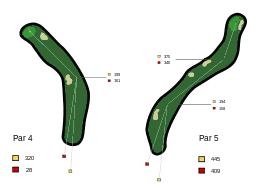
Typical doglegs. Left: "dogleg left". Right: "double dogleg".
While many holes are designed with a direct line-of-sight from the teeing ground to the green, a hole may bend either to the left or to the right. This is called a "dogleg", in reference to the similarity to a dog's ankle. The hole is called a "dogleg left" if the hole angles leftwards, and a "dogleg right" if the hole angles rightwards. A hole's direction may bend twice, which is called a "double dogleg".
Just as there are good-quality grasses for putting greens, there are good-quality grasses for the fairway and rough. The quality of grass influences the roll of the ball as well as the ability of the player to "take a divot" (effectively, the ability to hit down into the ball, hitting the ball first, then hitting the turf and removing a portion of it as the club continues its arc). Fairways on prestigious tours, like the PGA Tour, are cut low. Mowing heights influence the play of the course. For example, the grass heights at U.S. Open events are alternated from one hole to the next in order to make the course more difficult. One example of this is the infamous roughs at U.S. Opens, which are often 3-5 inches high, depending on how close to the fairway or green the section of grass will be. This makes it difficult for a player to recover after a bad shot.
Some variants of grass used for fairways and roughs are bent grass, Tifway 419 Bermuda grass,[4] rye grass, Kentucky bluegrass, and Zoysiagrass. As in putting-green grass types, not every grass type works equally well in all climate types.
Hazards
Holes often include hazards, which are special areas that have additional rules for play, and are generally of two types: (1) water hazards, such as ponds, lakes, and rivers; and (2) bunkers, or sand traps.
Special rules apply to playing a ball that falls in a hazard. For example, a player may not touch the ground or water with his club before playing the ball, not even for a practice swing. A ball in any hazard may be played as it lies without penalty. If it cannot be played from the hazard, the ball may be hit from another location, generally with a penalty of one stroke. The Rules of Golf specify exactly the point from which the ball may be played outside a hazard. Bunkers are small to medium areas, usually lower than the firway but of varying topology, that are filled with sand and generally incorporate a raised lip or barrier. It is more difficult to play the ball from sand than from grass, as the ball may embed itself into the sand, and the loose nature of the sand and more severe sloping of many bunkers make taking one's stance more difficult. As in any hazard, a ball in a bunker must be played without touching the sand with the club except during the stroke, and loose impediments (leaves, stones, twigs) must not be moved before making the stroke.
Courses may also have other design features which the skilled player will avoid; there are earth bunkers (pits or depressions in the ground that are not filled with sand but require a lofted shot to escape), high grass and other dense vegetation, trees or shrubs, ravines and other rocky areas, steep inclines, etc.; while disadvantageous to play from, these are typically not considered "hazards" unless specifically designated so by the course (a ravine or creekbed may be termed a "water hazard" even if completely dry).
Putting green
The putting green, or simply the green, is an area of very closely trimmed grass on relatively even, smooth ground surrounding the hole, allowing players to make precision strokes on it. To "putt" is to play a stroke on this surface, usually with the eponymous "putter" club, which has very low loft so that the ball rolls smoothly along the ground, and hopefully into the cup. The shape and topology of the green can vary almost without limit, but for practical purposes the green is usually flatter than other areas of the course (though gentle slopes and undulations can add extra challenge to players who must account for these variations in their putting line), and typically does not include any enclosed hazards such as sand or water (though these hazards may be - and often are - placed adjacent to the green).
The green is typically surrounded by slightly higher grass (cut about the same height as that of the fairway), and then by rough. This longer grass between the green and rough is known as the fringe and is designed to slow and stop balls rolling along the green from an approach shot or errant putt, preventing them from exiting the green. Though putting strokes can be made on it, the higher grass can interfere with the path of the ball, so players often choose to use a lofted club such as an iron to make a "chip shot" or a "bump and run", where the ball carries in the air for a few yards and then rolls along the green like a normal putt.
The grass of the putting green (more commonly just "green") is cut very short so that a ball can roll for a long distance. The most common types of greens for cold winter, but warmer summer regions (i.e., not extremely warm, as in the Southern and Southwestern United States) are bent grass greens. A green may consist of a thin carpet so that bad weather is not allowed to become a serious factor in maintaining the course. These are considered the best greens because they may be cut to an extremely low height, and because they may be grown from seed. Bent grass does not have grain, which makes it superior as a putting surface. However, bent grass may become infested with poa annua, a costly and time-consuming weed.
Putting greens are not all of the same quality. The finest-quality greens are well-kept so that a ball will roll smoothly over the closely mowed grass. Excess water can be removed from a putting green using a machine called a water hog. Golfers describe a green as fast if a light stroke on the ball makes it roll a long distance; conversely, on a slow green a stronger stroke is necessary to roll the ball the same distance. The exact speed of a green can be determined with a stimp meter. By collecting sample measurements, golf courses can be compared in terms of average green speed. It is, however, illegal by the Rules of Golf to test the speed of a green while playing by rolling a ball on it, or by feeling or rubbing the green.
Most golf courses have only par-3, -4, and -5 holes, though some courses include par-6 holes. (The Ananti CC and the Satsuki golf course in Sano, Japan are the only courses with par 7 holes.) Typical distances for the various holes from standard tees are as follows.
Men
- Par 3 – 250 yards (230 m) and below
- Par 4 – 251–450 begin_of_the_skype_highlighting 4 – 251–450 end_of_the_skype_highlighting yards (230–410 m)
- Par 5 – 451–690 begin_of_the_skype_highlighting 5 – 451–690 end_of_the_skype_highlighting yards (412–630 m)
- Par 6 – 691 yards (632 m) or more
Women
- Par 3 – 210 yards (190 m) and below
-Par 4 – 211–400 begin_of_the_skype_highlighting 4 – 211–400 end_of_the_skype_highlighting yards (193–370 m)
- Par 5 – 401–575 begin_of_the_skype_highlighting 5 – 401–575 end_of_the_skype_highlighting yards (367–526 m)
- Par 6 – 575 yards (526 m) or more
Harder or easier courses may have longer- or shorter-distance holes, respectively. Terrain can also be a factor, so that a long downhill hole might be rated par 4, but a shorter uphill or notably treacherous hole might be rated par 5. Tournament players will usually play from a longer-distance tee box (the Championship or Tournament tee) that is behind the standard men's tee, which increases the typical distance of each par; a par-3 hole can be up to 290 yards (270 m), and longer par-4 holes can measure up to 520 yards (480 m). This compensates for the generally longer distance pro players can put on tee and fairway shots as compared to the average "bogey golfer".
Other areas
Some areas of the course are designated "ground under repair" (GUR), where greenskeepers are making repairs or where the course has been damaged. A ball coming to rest in this area may be lifted, then played from outside the GUR without penalty. Certain man-made objects on the course are defined as obstructions (e.g., distance posts or gardens), and specific rules determine how a golfer may proceed when his play is impeded by them.
Driving range
Often, a golf course will include among its facilities a practice range or driving range, usually with practice greens, bunkers, and driving areas. Markers showing distances are usually included on a practice range for the golfer's information. Driving ranges are also commonly found as separate facilities, unattached to a golf course, where players may simply hit balls into the range for practice or enjoyment.
There may even be a practice course (often shorter and easier to play than a full-scale course), where players may measure the distance they can obtain with a specific club, or in order to improve their swing technique. Practice courses often consist of old holes of a previous design that are kept and maintained for practice purposes or as substitute holes if one or more holes become unplayable; a 21-hole golf course, for instance, will have three additional holes that can be used for practice or as substitutes for a flooded or otherwise damaged hole.
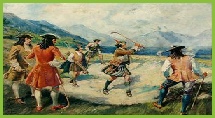
Golf origins

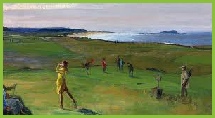
Golfe course evolution

Golf clubs components
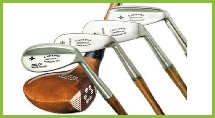
Golf set
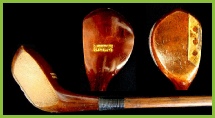
Golf woods
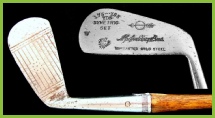
Long and mid irons
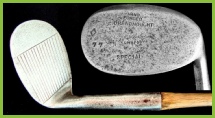
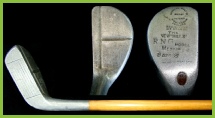
Golf putters
Short irons and wedges
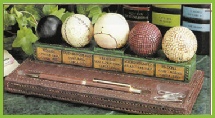
Golf balls
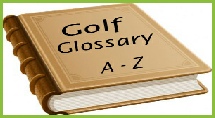
Glossary